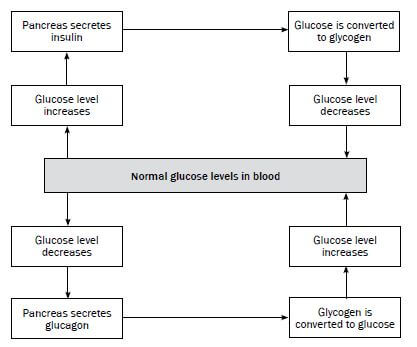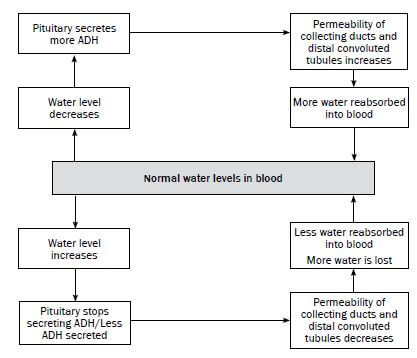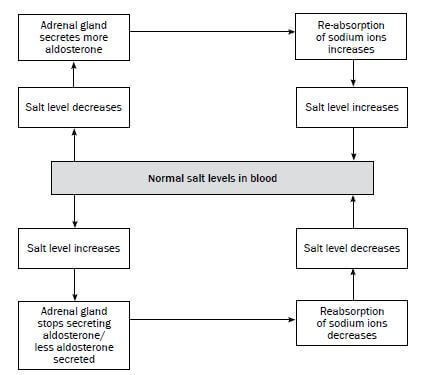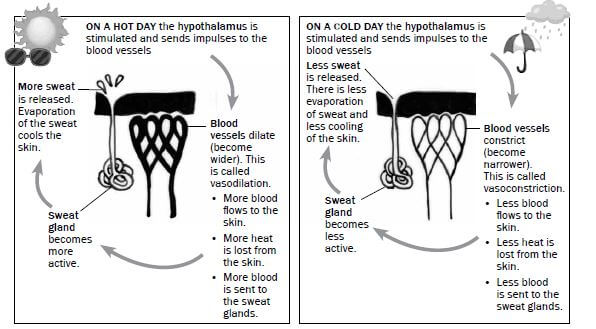HOMEOSTASIS IN HUMANS GRADE 12 NOTES - LIFE SCIENCES STUDY GUIDES
Share via Whatsapp Join our WhatsApp Group Join our Telegram GroupHOMEOSTASIS IN HUMANS
LIFE SCIENCES
STUDY GUIDES AND NOTES
GRADE 12
CHAPTER 8: HOMEOSTASIS IN HUMANS
8.1 Introduction
Homeostasis is the process of maintaining a constant internal environment within the body. The internal environment refers to the blood and tissue fluid that surrounds the cells of the body. Homeostasis enables the body to function efficiently, despite changes that might occur in the external or internal environment.
Changes in temperature, glucose levels, carbon dioxide levels, water levels and salt levels of the internal environment affects the homeostatic balance of the body. Negative feedback mechanisms operate in the human body to detect changes or imbalances in the internal environment and to restore the balance.
8.2 Negative feedback mechanisms
General sequence of events in a negative feedback mechanism :
Step 1: An imbalance is detected.
Step 2: A control centre is stimulated.
Step 3: Control centre responds.
Step 4: Message sent to target organs/s.
Step 5: The target organ responds.
Step 6: It opposes/reverses the imbalance.
Step 7: Balance is restored.
8.2.1 The regulation of glucose levels in the internal environment
When the glucose level in the blood increases above normal levels: | |
Step 1 | Glucose levels in the blood increase above normal levels |
Step 2 | The pancreas is stimulated |
Step 3 | to secrete insulin into the blood |
Step 4 | Insulin travels in the blood to the liver |
Step 5 | where it stimulates the conversion of excess glucose to glycogen which is then stored |
Step 6 | The glucose level in the blood now decreases |
Step 7 | and returns to normal |
When the glucose level in the blood decreases below normal levels: | |
Step 1 | Glucose levels in the blood decrease below normal levels |
Step 2 | The pancreas is stimulated |
Step 3 | to secrete glucagon into the blood |
Step 4 | Glucagon travels in the blood to the liver |
Step 5 | where it stimulates the conversion of stored glycogen to glucose |
Step 6 | The glucose level in the blood now increases |
Step 7 | and returns to normal |

Figure 8.1 Negative feedback mechanism to regulate the glucose levels
8.2.2 The regulation of carbon dioxide levels in the internal environment
When the CO2 level in the blood increases above normal levels: | |
Step 1 | CO2 levels in the blood increase above normal levels |
Step 2 | Receptor cells in the carotid artery in the neck are stimulated |
Step 3 | To send impulses to the medulla oblongata in the brain |
Step 4 | Medulla oblongata stimulates breathing muscles (intercostal muscles and diaphragm) and heart |
Step 5 | Breathing muscles contract more actively - increases the rate and depth of breathing. The heart beats faster. |
Step 6 | More CO2 is taken to and exhaled from the lungs |
Step 7 | The CO2 level in the blood returns to normal |
8.2.3 The regulation of water balance in the internal environment (osmoregulation)
Related Items
When the blood has less water than normal: | |
Step 1 | Blood has less water than normal |
Step 2 | The hypothalamus is stimulated |
Step 3 | and sends impulses to the pituitary gland to secrete more ADH |
Step 4 | ADH travels in the blood to the kidneys |
Step 5 | ADH increases the permeability of the collecting ducts and the distal convoluted tubules of the kidney |
Step 6 | More water is re-absorbed and passed to the surrounding blood vessels |
Step 7 | The water level in the blood returns to normal |
When the blood has more water than normal: | |
Step 1 | Blood has more water than normal |
Step 2 | The hypothalamus is stimulated |
Step 3 | and sends impulses to the pituitary gland to stop secreting ADH/to secrete less ADH |
Step 4 | No ADH/less ADH travels in the blood to the kidneys |
Step 5 | The collecting ducts and the distal convoluted tubules of the kidney become less permeable to water |
Step 6 | Less water is re-absorbed and passed to the surrounding blood vessels. More water is now lost |
Step 7 | The water level in the blood returns to normal |

Figure 8.2 Negative feedback mechanism to regulate the water balance
8.2.4 The regulation of salt balance in the internal environment
When the salt level in the blood decreases: | |
Step 1 | The salt level in the blood decreases |
Step 2 | Receptor cells in the afferent and efferent arterioles of the kidney detect the low salt level |
Step 3 | The adrenal gland is stimulated |
Step 4 | into secreting more aldosterone |
Step 5 | Aldosterone increases the re-absorption of sodium ions from the renal tubules in the kidney into the surrounding blood vessels |
Step 6 | The salt level in the blood vessels increases |
Step 7 | and returns to normal |
When the salt level in the blood increases: | |
Step 1 | The salt level in the blood increases |
Step 2 | Receptor cells in the afferent and efferent arterioles of the kidney detect the high salt level |
Step 3 | The adrenal gland is stimulated |
Step 4 | to stop secreting aldosterone/to secrete less aldosterone |
Step 5 | This decreases the re-absorption of sodium ions from the renal tubules in the kidney into the surrounding blood vessels |
Step 6 | The salt level in the blood vessels decreases |
Step 7 | and returns to normal |

Figure 8.3 Negative feedback mechanism to regulate the salt balance
8.3 The process of temperature regulation
Temperature regulation is the control of body temperature to keep it as close to 37ºC as possible to enable the body to function normally.
Body temperature is regulated by the hypothalamus in the brain and the blood vessels and sweat glands in the skin.
Figure 8.4 below shows how the body temperature is regulated by the hypothalamus and the skin.
Figure 8.4 The homeostatic mechanism to regulate body temperature
Activity 1
Questions
1. Name the heat regulation centre in the brain. (1)
2. What happens to the blood vessels of the skin on a cold day? (1)
3. Describe how the state of the blood vessels mentioned in question 2 decreases heat loss. (4)
4. What happens to blood vessels of the skin on a hot day? (1)
5. Describe how the state of the blood vessels mentioned in question 4 increases heat loss. (4) [11]
Answers to activity 1
1. Hypothalamus✔ (1)
2. Blood vessels constrict✔/vasoconstriction (1)
3.
- Less blood flows to the surface of the skin.✔
- Less heat is lost from the surface of the skin.✔
- Less blood flows to the sweat glands.✔
- Sweat glands release less sweat.✔
- Less evaporation of sweat.✔
- Less cooling of the skin on a cold day.✔ (any 4)(4)
4. Blood vessels dilate✔/vasodilation (1)
5.
- More blood flows to the surface of the skin.✔
- More heat is lost from the surface of the skin.✔
- More blood flows to the sweat glands.✔
- Sweat glands release more sweat.✔
- Evaporation of sweat✔
- cools the skin on a hot day.✔ (any 4)(4) [11]